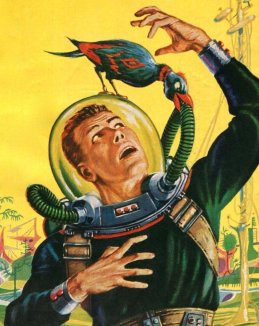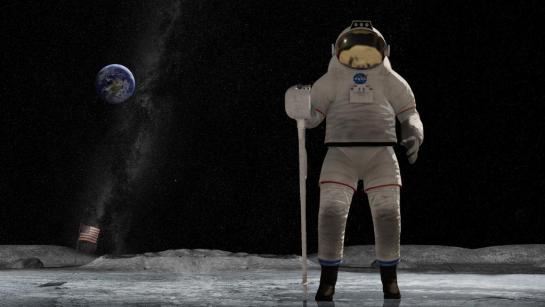My partner and I spent much of March watching episodes of Star Trek: The Next Generation in mostly random order. I’d seen plenty of Trek before—watching pretty much all of DS9 and Voyager as a teenager, and enjoying the more recent J.J. Abrams reboot—but it’s been years since I really considered the franchise as a piece of science fiction. My big takeaway is…TNG is bonkers, and that’s okay. The show is highly watchable because it’s really just a set of character moments, risk taking, and ethical conundrums strung together with pleasing technobabble, which soothes and hushes the parts of our brain that might object to the plot based on some technicality. It’s a formula that will probably never lose its appeal.
But there is one thing that does bother me: how can the crew respond to Picard’s orders so fast? Like, beyond-the-limits-of-reason fast.

How are you making that so?
When the Enterprise-D encounters hostile aliens, ship malfunctions, or a mysterious space-time anomaly, we often get dynamic moments on the bridge that work like this. Data, Worf and the other bridge crew, sometimes with input from Geordi in engineering, call out sensor readings and ship functionality metrics. Captain Picard stares toward the viewscreen/camera and gives orders, sometimes intermediated by Commander Riker. Worf or Data will tap once or twice on their consoles and then quickly report the results—i.e. “our phasers have no effect” or “the warp containment field is stabilizing,” that sort of thing. It all moves very quickly, and even though the audience doesn’t quite know the dangers of tachyon radiation or how tricky it is to compensate for subspace interference, we feel a palpable urgency. It’s probably one of the most recognizable scenes-types in television.
Now, extradiegetically, I think there are very good reasons to structure the action this way. It keeps the show moving, keeps the focus on the choices, rather than the tech. And of course, diegetically, their computers would be faster than ours, responding nearly instantaneously. The crew are also highly trained military personnel, whose focus, reaction speed, and knowledge of the ship’s systems are kept sharp by regular drills. The occasional scenes we get of tertiary characters struggling with the controls only drives home how elite the Enterprise senior staff are.

Nonetheless, it is one thing to shout out the strength of the ship’s shields. No doubt Worf has an indicator at tactical that’s as easy to read as your laptop’s battery level. That’s bound to be routine. But it’s quite another for a crewmember to complete a very specific and unusual request in what seems like one or two taps on a console. There are countless cases of the deflector dish or tractor beam being “reconfigured” to emit this or that kind of force or radiation. Power is constantly being rerouted from one system to another. There’s a great deal of improvisational engineering by all characters.
Just to pick examples in my most recent days of binging: in “Descent, Part 2,” for instance, Beverly Crusher, as acting captain, tells the ensign at ops to launch a probe with the ship’s recent logs on it, as a warning to Starfleet, thus freeing the Enterprise to return through a transwarp conduit to take on The Borg. Or in the DS9 episode “Equilibrium”—yes, we’ve started on the next series now that TNG is off Netflix—while investigating a mysterious figure from Jadzia’s past, Sisko instructs Bashir to “check the enrollment records of all the Trill music academies during Belar’s lifetime.” In both cases, the order is complete in barely a second.
Even for Julian Bashir—a doctor and secretly a mutant genius—there is no way for a human to perform such a narrow and out-of-left-field search without entering a few parameters, perhaps navigating via menus to the correct database. From a UX perspective, we’re talking several clicks at least!
There is a tension in design between…
- Interface elements that allow you to perform a handful of very specific operations quickly (if you know where the switch is), and…
- Those that let you do almost anything, but slower.
For instance, this blog has big colorful buttons that make it easy to get email updates about new posts or to donate to a tip jar. If you want to find a specific post, however, you have to type something into the search box or perhaps scroll through the list of TV/movie properties on the right. While the 24th Century no doubt has somewhat better design than WordPress, they are still bound by this tension.
Of course it would be boring to wait while Bashir made the clicks required to bring up the Trill equivalent of census records or LexisNexis. With movie magic they simply edit out those seconds. But I think it’s interesting to indulge in a little backworlding and imagine that Starfleet really does have the technology to make complex general computing a breeze. How might they do it?
Enter the Ship’s AI
One possible answer is that the ship’s Computer—a ubiquitous and omnipresent AI—is probably doing most of the heavy lifting. Much like how Iron Man is really Jarvis with a little strategic input from Tony, I suspect that the Computer listens to the captain’s orders and puts the appropriate commands on the relevant crewman’s console the instant the words are out of Picard’s mouth. (With predictive algorithms, maybe even just before.) The crewman then merely has to confirm that the computer correctly interpreted the orders and press execute. Similarly, the Computer must be constantly analyzing sensor data and internal metrics and curating the most important information for the crew to call out. This would be in line with the Active Academy model proposed in relation to Starship Troopers.

Centaurs, Minotaurs, and anticipatory computing
I’ve heard this kind of human-machine relationship called “Centaur Computing.” In chess, for instance, some tournaments have found that human-computer teams outperform either humans or computers working on their own. This is not necessarily intuitive, as one would think that computers, as the undisputed better chess players, would be hindered by having an imperfect human in the mix. But in fact, when humans can offer strategic guidance, choosing between potential lines that the computer games out, they often outmaneuver pure-AIs.
I often contrast Centaur Computing with something I call “Minotaur Computing.” In the Centaur version—head of a man on the body of a beast—the human makes the top-level decision and the computer executes. In Minotaur Computing—head of a beast with the body of a man—the computer calls the shots and leaves it up to human partners to execute. An example of this would be the machine gods in Person of Interest, which have no Skynet Terminator armies but instead recruit and hire human operatives to carry out their cryptic plans.
In some ways this kind of anticipatory computing is simply a hyper-advanced version of AI features we already have today, such as when Gmail offers to complete my sentence when I begin to type “thank you for your time and consideration” at the end of a cover letter.
Hi, it looks like you’re trying to defeat the Borg…
In this formulation, the true spiritual ancestor of the Starfleet Computer is Clippy, the notorious Microsoft Word anthropomorphic paperclip helper, which would pop up and make suggestions like “It looks like you’re writing a letter. Would you like help?” Clippy was much maligned in popular culture for being annoying, distracting, and the face of what was in many ways a clunky, imperfect software product. But the idea of making sense of the user’s intentions and offering relevant options isn’t always a bad one. The Computer in Star Trek performs this task so smoothly, efficiently, and in-the-background, that Starfleet crews are able to work in fast-paced harmony, acting on both instinct and expertise, and staying the heroes of their stories.

Admittedly, this deftness is a bit at odds with the somewhat obtuse behavior the Computer often displays when asked a question directly, such as demanding you specify a temperature when you request a glass of water. Given how often the Computer suffers strange malfunctions that complicate life on the Enterprise for days a time, one wonders if the crew feel as though they are constantly negotiating with a kind of capricious spirit—usually benign but occasionally temperamental and even dangerously creative in its interpretations of one’s wishes, like a djinn. Perhaps they rarely complain about or even mention the Computer’s role in Clippy-ing orders onto their consoles because they know better than to insult the digital fairies that run the turbolifts and replicate their food.
All of which brings a kind of mystical cast to those rapid, chain-of-command-tightened exchanges amongst the bridge crew when shit hits the fan. When Picard gives his crew an order, he’s really talking to the Computer. When Riker offers a sub-order, he’s making a judgment call that the Computer might need a little more guidance. The crew are there to act as QA—a general-intelligence safeguard—confirming with human eyes and brain that the Computer is interpreting Picard correctly. The one or two beeps we often hear as they execute a complex command are them merely dismissing incorrect or confused operation-lines. They report back that the probe is ready or the phasers are locked, as the captain wished, and Picard double confirms with his iconic “make it so.” It’s a multilayered checking and rechecking of intentions and plans, much like the military today uses to prevent miscommunications, but in this case with the added bonus of keeping the reins on a powerful but not always cooperative genie.
There’s a good argument to be made that this is the relationship we want to have with technology. Smooth and effective, but with plenty of oversight, and without the kind of invasive elements that right now make tech the center of so many conversations. We want AI that gives us computational superpowers, but still keeps us the heroes of our stories.
Andrew Dana Hudson is a speculative fiction author, researcher, and theorist. His first book, Our Shared Storm: A Novel of Five Climate Futures, is fresh off the press. Check it out here. And follow his work via his newsletter, solarshades.club.










































































































































